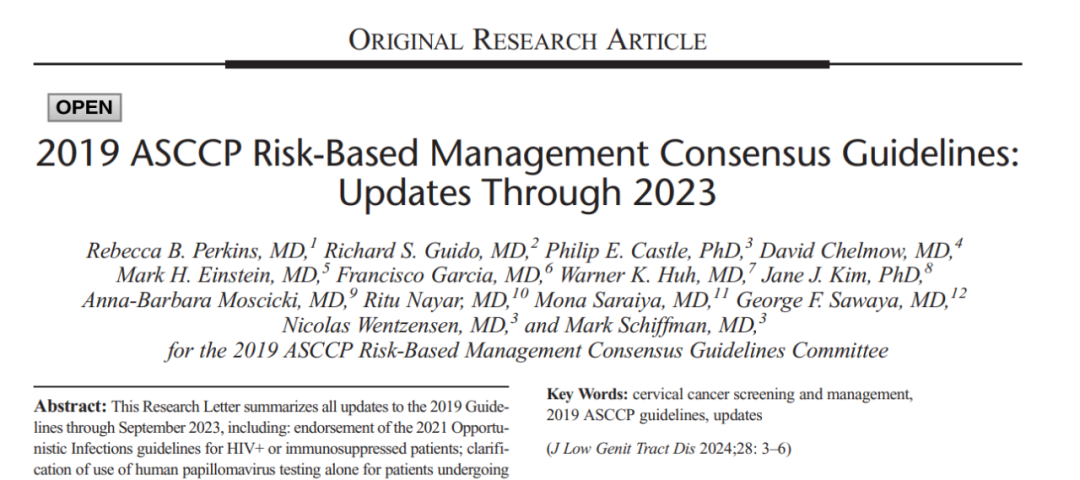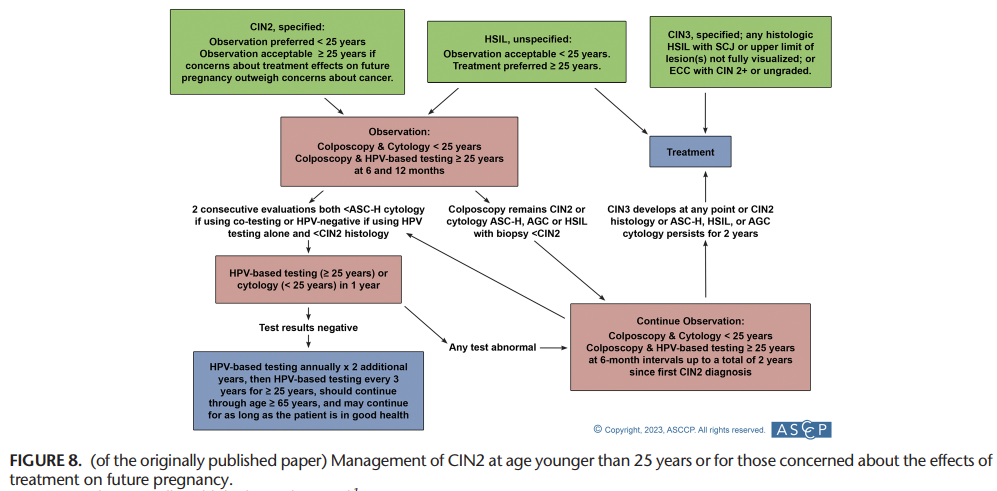
2024年1月,2019 ASCCP风险管理共识指南对既往发布的内容进行了部分勘误和更新,具体内容如下:
2019年ASCCP指南批准了2018《HIV感染的成人和青少年机会性感染的预防和治疗指南》,随后于2021年进行了更新。更新后的《机会性感染指南》建议从21岁开始进行宫颈癌筛查,而之前的指南建议在初次性行为1年后开始筛查。
“1) Endorsement of the 2021 Opportunistic Infections Guidelines:
The 2019 Guidelines endorsed the 2018“Guidelines for the Prevention and Treatment of Opportunistic Infections in Adultsand Adolescents with HlV”that were current at the time of publication.The Opportunistic Infections Guidelines were subsequentlyupdated in 2021.The updated Opportunistic Infections Guidelines recommend beginning cervical cancer screening at age 21 years, a change from previous guidelines that recommended initiating screening 1 year after sexual debut. ”
指南明确了可对接受CIN2观察患者单独进行HPV检测或联合筛查
建议声明已更新,以澄清对于CIN2观察的患者,单独HPV检测和联合筛查都是可接受的。
对于组织学诊断为HSIL的患者(CIN2),如果对治疗影响未来妊娠的担忧超过对癌症的担忧,只要鳞柱交界处完全可见,且宫颈内取样未发现CIN2+或未分级的CIN,则可以接受观察或治疗。如果组织学上的HSIL不能被界定为CIN2,则首选治疗,但可以接受观察。对于25岁或以上的患者,观察包括间隔6个月的阴道镜检查和HPV检测,最长达2年;在监测期间,如果所有评估显示低于组织学CIN2,且联合筛查结果低于ASC-H或连续两次单独HPV检测阴性,后续监测应在第二次评估后1年进行,并使用基于HPV的检测。如果连续3年监测结果为阴性,则进行长期监测。如果CIN 2持续存在2年,建议进行治疗。图8已更新以反映此更改。
“2) Clarification to recommendation statement for patients undergoing observation of CIN2:
The recommendation statement has been updated to clarify that both HPV testing alone and cotesting are acceptable for patients undergoing observation of CIN2. The revised recommenda-tion now states:
Guideline: For patients with a diagnosis of histologic HSIL(CIN 2) whose concerns about the effects of treatment on a future pregnancy outweigh their concerns about cancer, either observation or treatment is acceptable provided the squamocolumnar junction is fully visualized and CIN 2+ or ungraded CIN is not identified on endocervical sampling (CⅡ) (see Figure 8). If the histologic HSIL cannot be specified as CIN 2, treatment is preferred, but observation is acceptable (CⅢ). For patients 25 years or older, observation includes colposcopy and HPV-based testing at 6-month intervals for up to 2 years (See Section K.1 of the 2019 Guidelines' for management of patients aged younger than 25 years). If during surveillance, all evaluations demonstrate less than CIN 2 histology and either less than ASC-H cytology if using cotesting or HPV negative if using HPV testing alone on 2 successive occasions, 6 months apart, subsequent surveillance should occur at 1 year after the second evaluation and use HPV based testing. If negative on 3 consecutive annual surveillance tests, proceed to long-term surveillance (Section J.3 of the 2019 Guidelines'). If CIN 2 remains present for a2-year period, treatment is recommended (CⅡ).Note that the original Figure 8 from the 2019 Guidelines was updated. The revised Figure 8 in this report replaces the older version and should be used for clinical management.”

建议声明已更新,没有必要在重复细胞学检查前等待2个月。
对于细胞学结果不满意,无、未知或HPV检测结果阴性的患者,建议尽快且不迟于4个月重复基于年龄的筛查(细胞学,联合筛查或HPV初筛)。
“3) Update to interval for repeating unsatisfactory cytology: The recommendation statement has been updated to reflect evidence that waiting 2 months before repeating the cytology test is not necessary.
Guideline: For patients with an unsatisfactory cytology result and no, unknown, or a negative HPV test result, repeat age-based screening (cytology, cotest, or primary HPV test) as soon as convenient and no later than 4 months is recommended (BⅢ).
(1)25岁及以上接受细胞学筛查的患者:对于25岁及以上单独接受细胞学筛查的患者,应遵循2012年ASCCP指南,对于≥LSIL细胞学结果,推荐阴道镜检查。
(2)推荐阴道镜检查但未完成的患者管理方案:推荐但未完成阴道镜检查的病例中,如果先前结果为细胞学高级别病变[ASC-H、AGC、≥HSIL],则建议进行阴道镜检查。如果先前的细胞学结果不是高级别病变,并且患者进行了重复HPV检测或联合筛查而不是阴道镜检查,如果重复检查的结果显示第二次HPV阳性和/或持续的细胞学异常(≥ASC-US),建议进行阴道镜检查。如果先前的细胞学结果不是高级别病变,并且患者进行了重复HPV检测或联合筛查而不是阴道镜检查,如果重复检查的结果显示第二次HPV阳性和/或持续的细胞学异常(≥ASC-US),建议进行阴道镜检查;如果重复检测的结果为HPV阴性或联合筛查阴性,1年内重复HPV检测或联合筛查是可接受的。
“4) Patient Scenarios Not Initially Addressed in the 2019 Guidelines:
(a) Guideline for individuals aged 25 and older screened with cytology alone: For individuals aged 25 years or older screened with cytology alone, the 2012 guidelines should be followed. In the 2012 guidelines, colposcopy is recommended for low-grade squamous intraepithelial lesion (LSIL) or a more severe cytologic interpretation.
(b) Guideline for cases in which colposcopy was previously recommended but not completed: In cases in which a colposcopy was previously recommended but not completed, the recommendation is for colposcopy if the previous result was high-grade cytology [atypical squamous cells cannot exclude high-grade squamous intraepithelial lesion (ASC-H), atypical glandular cells (AGC), HSIL, or a more severe cytologic interpretation. If the previous cytology result was not high grade, and the patient undergoes repeat testing with HPV testing or cotesting instead of colposcopy: colposcopy is recommended if the result on repeat testing indicates a second consecutive HPV positive result and/or persistent cytologic ab-normality (ASC-US or a more severe cytologic interpretation);repeat HPV testing or cotesting in 1 year is acceptable if the result on repeat testing is HPV negative or cotest negative.”
1)对图7的图例的更正,澄清治疗后总共需要进行3次hpv阴性检测,以恢复到3年的检测间隔:
2019年指南的风险估计表明,在组织学HSIL/CIN2-3切除治疗后,需要每1年连续进行三次HPV检测或联合筛查阴性,以确定风险足够低的患者,可以安全返回3年的检测间隔。2019年指南建议在切除手术后6个月进行第一次检查。图7错误地推荐了在6个月时进行HPV检测或联合筛查,随后连续3年进行HPV检测或联合筛查(总共4次连续阴性检测)。本次对图7进行了修正,澄清在治疗后的6个月、18个月、30个月总共需要3次基于HPV的阴性检测,以恢复到3年的检测间隔。并对随访数字还进行了修改,以明确随访应间隔3年,至少随访25年,并且持续到65岁,只要患者健康状况良好,就可以继续随访。
“1) Correction to Figure 7 clarifying that a total of 3 negative HPV-based tests are needed after treatment to return to a 3-year testing interval:
Risk estimates for the 2019 Guidelines indicate that, following excisional treatment for histologic HSIL/CIN2-3, three consecutive negative HPV tests or cotests are needed at 1-year intervals to identify a group of patients at sufficiently low risk that they can safely return to 3-year testing interval. The 2019 Guide lines recommend that the first test occur 6 months after the excisional procedure. Figure 7 erroneously recommended an HPV test or cotest at 6 months followed by 3 consecutive an-nual HPV or cotests (a total of 4 consecutive negative tests )This has been corrected to recommend the first HPV test or cotest at 6 months followed by additional HPV or cotests at 18 months and 30 months. The figure has also been modified to clarify that follow-up should continue at 3-year intervals for a minimum of 25 years and through at least age 65 years and may continue for as long as the patient is in good health.”

2)发布于2020年10月:对2019年指南图2的图例进行了修订,明确了出现轻度筛查异常结果,而阴道镜检查未发现高级别病变后的处理算法,为了清晰起见,此处重复了图中的图例:
该图展示了如何根据风险估计来管理常见轻度异常筛查结果的患者(HPV阳性,ASC-US),最初的筛查结果会导致阴道镜检查(即刻风险4.45%)。如果阴道镜检查显示<CIN2,5年风险为2.9%(1年随访)。在为期1年的回访中,第二次HPV阳性、ASC-US的即刻风险为3.1%。请注意,如果阴道镜检查是任何轻度异常结果(即<ASC-H),则建议进行类似的处理。如果第二次阴道镜检查后的HPV检测结果为阴性,建议3年后复诊。如第二次阴道镜后复查检查结果是HPV阳性伴任意细胞学结果,或者是HPV检测阴性且细胞学结果≥ASC-H,都建议进行阴道镜检查。对于HPV阴性的ASC-US/LSIL,建议在1年随访。
“2) Prior Correction to Figure 2 Legend Published October 2020: The legend for Figure 2 of the original 2019 Guidelines article was updated to clarify the algorithm for management after a minimally abnormal screening test result followed by a colposcopy at which high-grade histology was not found. The figure legend is repeated here for clarity:”
“This figure demonstrates how a patient with a common minimally abnormal screening test result (HPV-positive ASC-US) would be managed based on risk estimates. The initial screening result would lead to colposcopy (immediate risk 4.45%). If colposcopy shows less than CIN 2, the 5-year risk is 2.9% (1-year return). At the 1-year return visit, a second HPV positive ASC-US result has an immediate risk of 3.1% (1-year return). Note similar management would be recommended if the initial ab-normality preceding colposcopy were any minimally abnormal test result (i.e., less severe than ASC-H). If the HPV based test performed for the second postcolposcopy surveillance test is negative, return in 3 years is recommended. If the second postcolposcopy surveillance test results are either a positive HPV test with any cytology result or a negative HPV test result with a cytology result of ASC-H or higher, colposcopy is recommended. Return in l year is recommended for HPV-negative ASC-US or LSIL results.”
参考文献:
Perkins RB, Guido RS, Castle PE, Chelmow D, Einstein MH, Garcia F, Huh WK, Kim JJ, Moscicki AB, Nayar R, Saraiya M, Sawaya GF, Wentzensen N, Schiffman M; 2019 ASCCP Risk-Based Management Consensus Guidelines Committee. 2019 ASCCP Risk-Based Management Consensus Guidelines:Updates Through 2023. J Low Genit Tract Dis. 2024 Jan 1;28(1):3-6. doi: 10.1097/LGT.0000000000000788. PMID: 38117563; PMCID: PMC10755815